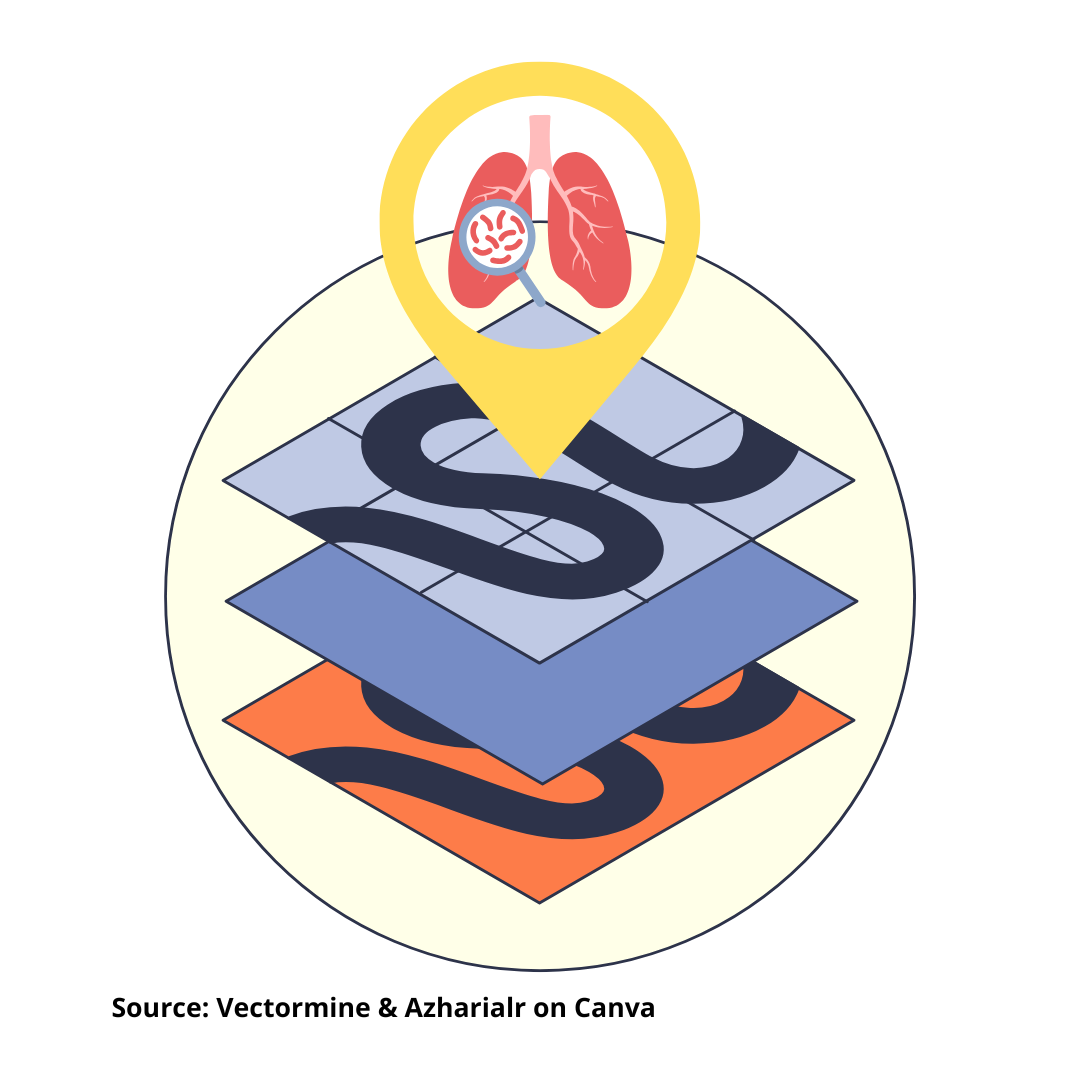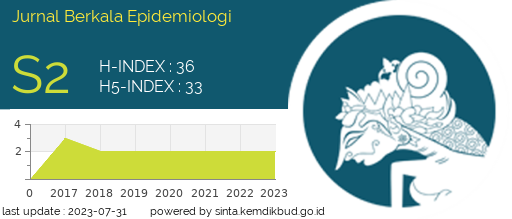GEOSPATIAL ANALYSIS TO IDENTIFY TUBERCULOSIS HOTSPOTS IN BANYUMAS REGENCY (2023) THROUGH SPATIAL AUTOCORRELATION
Analisis Geospasial untuk Mengidentifikasi Titik Rawan Tuberkulosis di Kabupaten Banyumas (2023) Melalui Autokorelasi Spasial

Downloads
Background: Banyumas Regency had the second-highest number of TBC cases in Central Java Province in 2023, totaling 7,060 cases. The incidence of TBC increased by approximately 27.27% from 2022 to 2023. Despite various TB control efforts, conventional epidemiological methods often fail to capture the spatial patterns of disease transmission, making it challenging to identify localized hotspots and effectively allocate resources. Purpose: This study aimed to analyze the spatial relationship between HIV prevalence, population density, healthy living behaviors, and housing conditions in relation to TBC incidence. Additionally, it sought to identify tuberculosis hotspots in Banyumas Regency. Methods: The data were obtained from the Banyumas Tuberculosis System Information in August 2024. Total of 4,853 registered patients who sought treatment and resided in Banyumas Regency in 2023 was assessed. TBC distribution patterns were analyzed using the spatial autocorrelation method through the Moran Index and Local Indicators of Spatial Associations (LISA). Results: The analysis revealed significant clustering of TBC incidence with HIV prevalence, clean and healthy living behavior, and population density. The significant dispersion was noted with healthy houses. Notably, six 27 subdistricts—Kembaran, North Purwokerto, South Purwokerto, East Purwokerto, Sokaraja, and Sumbang—demonstrated significant local spatial autocorrelation. Conclusion: The study found TBC incidence was clustered in areas with high HIV prevalence, poor living conditions, and high population density, while healthy houses showed a dispersed pattern, highlighting the importance of prioritizing interventions, policy changes, and resource allocation.
Natarajan A, Beena PM, Devnikar A V., Mali S. A systemic review on tuberculosis. Indian Journal of Tuberculosis. 2020 Jul;67(3):295–311.
CDC. Core curriculum on Tuberculosis: what the clinician should know. In 2021 [cited 2023 Sep 11].
Bai W, Ameyaw EK. Global, regional and national trends in tuberculosis incidence and main risk factors: a study using data from 2000 to 2021. BMC Public Health. 2024 Jan 2;24(1):12.
WHO. Global Tuberculosis report 2023. Geneva; 2024 [cited 2025 Feb 20].
WHO. Global Tuberculosis Report 2024. 2025 [cited 2025 May 31].
Indonesian Health Ministry. Indonesia Health Profile in 2023. Jakarta; 2024 [cited 2025 May 31].
Central Java Provincial Health Office. Central Java Health Profile in 2023. Semarang; 2024.
Banyumas District Health Office. Banyumas Regency Health Profile 2023. Banyumas; 2024 [cited 2024 Feb 2].
Yang H, Ruan X, Li W, Xiong J, Zheng Y. Global, regional, and national burden of tuberculosis and attributable risk factors for 204 countries and territories, 1990–2021: a systematic analysis for the Global Burden of Diseases 2021 study. BMC Public Health. 2024 Nov 11;24(1):3111.
Zhang SX, Wang JC, Yang J, Lv S, Duan L, Lu Y, et al. Epidemiological features and temporal trends of the co-infection between HIV and tuberculosis, 1990–2021: findings from the Global Burden of Disease Study 2021. Infect Dis Poverty. 2024 Aug 16;13(1):59.
Bares SH, Swindells S. Latent Tuberculosis and HIV infection. Curr Infect Dis Rep. 2020 Jul 5;22(7):17.
Madao EP, Hermawati E, Putri NAA, Makful MR. Evaluating spatial analysis of tuberculosis prevalence to identify priority districts or municipalities that need policy attention in West Java. BKM Public Health and Community Medicine. 2024 Apr 30;e12160.
Khoirunissa HA. Tuberculosis (TB) risk mapping in Surakarta city using spatial empirical Bayes. Indonesian Journal of Applied Statistics. 2021 Jan 23;3(2):78.
Njagi LN, Nduba V, Mureithi MW, Mecha JO. Prevalence and predictors of tuberculosis infection among people living with HIV in a high tuberculosis burden context. BMJ Open Respir Res. 2023 May 17;10(1):e001581.
Sultana ZZ, Hoque FU, Beyene J, Akhlak-Ul-Islam Md, Khan MHR, Ahmed S, et al. HIV infection and multidrug resistant tuberculosis: a systematic review and meta-analysis. BMC Infect Dis. 2021 Dec 11;21(1):51.
Hasnanisa N, Prasetyo S, Handayani Y. Factors of Pulmonary Tuberculosis: a spatial analysis. Jurnal Ilmiah Kesehatan Masyarakat. 2023;15(3).
Maulana AP, Delani S, Ardiansyah A, Agusman R, Handawati R. Global and local autocorrelation analysis of pulmonary tuberculosis in East Nusa Tenggara province. Jurnal Kesehatan Vokasional. 2024 May 31;9(2).
Teibo TKA, Andrade RL de P, Rosa RJ, Tavares RBV, Berra TZ, Arcêncio RA. Geo-spatial high-risk clusters of tuberculosis in the global general population: a systematic review. BMC Public Health. 2023 Aug 19;23(1):1586.
Gemechu LL, Debusho LK. Spatial co-clustering of Tuberculosis and HIV in Ethiopia. Diseases. 2022 Nov 17;10(4).
Hanifah AD, Razak R, Sunarsih E, Budiastuti A. The relationship between knowledge and host behavior with pulmonary tuberculosis cases in the productive age in Rantau Alai District, Ogan Ilir Regency. Jurnal Ilmu Kesehatan Masyarakat. 2024 Jul 11;15(2):209–19.
Noerhalimah T. The scope of PHBS in household and healthy home with the incidence of Tuberculosis in West Java. Journal of Public Health Research and Community Health Development. 2020 Oct 28;4(1):28.
Nurdiawati E, Indar, Daningrum D, Asra, Ervan, Sani HA. The relationship between physical conditions of the house and healthy living behavior on the recovery of Tuberculosis patients. Journal of Public Health Metters. 2024;1(3).
Lee JY, Kwon N, Goo G yeon, Cho S il. Inadequate housing and pulmonary tuberculosis: a systematic review. BMC Public Health. 2022 Dec 30;22(1):622.
Lee JY, Kwon N, Goo G yeon, Cho S il. Inadequate housing and pulmonary tuberculosis: a systematic review. BMC Public Health. 2022 Dec 30;22(1):622.
Fikri Z, Samudra WBS, Kurnia AD, Masruroh NL, Melizza N. The relationship between healthy housing status and the incidence of tuberculosis in the Campurdarat sub-district area. Indonesian Health Science Journal. 2021 Sep 30;1(2).
Liyew AM, Clements ACA, Akalu TY, Gilmour B, Alene KA. Ecological-level factors associated with Tuberculosis incidence and mortality: A systematic review and meta-analysis. PLOS Global Public Health. 2024 Oct 15;4(10):e0003425.
Sari DK, Mardiansjah FH. The development of small towns in Banyumas Regency and the potential for strengthening their role in the village-city relationship.. Tata Kota dan Daerah. 2022 Dec 31;14(2):115–26.
Chirenda J, Gwitira I, Warren RM, Sampson SL, Murwira A, Masimirembwa C, et al. Spatial distribution of Mycobacterium Tuberculosis in metropolitan Harare, Zimbabwe. PLoS One. 2020 Apr 21;15(4):e0231637.
Gwitira I, Karumazondo N, Shekede MD, Sandy C, Siziba N, Chirenda J. Spatial patterns of pulmonary tuberculosis (tb) cases in Zimbabwe from 2015 to 2018. PLoS One. 2021 Apr 8;16(4):e0249523.
Lestari AA, Makful MR, Okfriani C. Spatial analysis of population density on tuberculosis cases in West Java province 2019-2021. Cahaya Mandalika. 2023 Jun 12;3(2):577–84.
- Every manuscript submitted to must observe the policy and terms set by the Jurnal Berkala Epidemiologi
- Publication rights to manuscript content published by the Jurnal Berkala Epidemiologi is owned by the journal with the consent and approval of the author(s) concerned. (download copyright agreement)
- Complete texts of electronically published manuscripts can be accessed free of charge if used for educational and research purposes according to copyright regulations.

JBE by Universitas Airlangga is licensed under a Creative Commons Attribution-ShareAlike 4.0 International License.























